Manfredís Last Visit to Schweidnitz
After returning to Germany, Manfred visited munitions factories to talk to striking workers. The social unrest was by now clearly noticeable throughout the country. The war had been long and bitter, and the people were suffering from shortage of food and lack of coal to heat their homes.
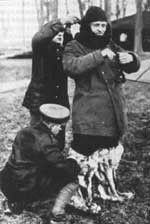 At the end of January 1918, Manfred went to his home in Silesia.
During his stay there, his mother and sister talked with him about
all the flyers that had been shot down, and they urged him to
be careful when he returned to the front. When he embraced his
mother on his departure, he suddenly had a grim foreboding. Because
Manfredís plane had been taken to Breslau for maintenance, he
had to take the train there from Schweidnitz. From Breslau he
flew to Berlin and after a short stay in the capital, Manfred
returned to the front.
At the end of January 1918, Manfred went to his home in Silesia.
During his stay there, his mother and sister talked with him about
all the flyers that had been shot down, and they urged him to
be careful when he returned to the front. When he embraced his
mother on his departure, he suddenly had a grim foreboding. Because
Manfredís plane had been taken to Breslau for maintenance, he
had to take the train there from Schweidnitz. From Breslau he
flew to Berlin and after a short stay in the capital, Manfred
returned to the front.
For Kaiser and Fatherland
The German spring offensive had started with bitter fighting in the trenches. On March 13th, 1918 Lothar crash-landed his disabled tri-plane. He sustained injuries in his face and legs and was hospitalized in Cambrai. Manfred visited his brother as often as he could and kept his mother informed of Lotharís recovery. By April, Manfred had scored 80 combat kills and the pressure for him to step down increased. He had become more valuable alive than dead for propaganda purposes. When his adjutant approached him that a position of Inspector of Fighter Aviation could be his, he replied: "No paper-shuffling for me, I am staying at the front".
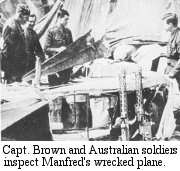 On April 21, 1918, Manfred, while hunting British planes, was caught
in a hail of bullets. His tri-plane staggered, slipped a couple
of hundred yards and crashed north of the Bray-Corbie road, a
mile and a half inside territory held by the Australians. Looking
inside the plane they saw the pilotís face smashed. They laid
his body beside his airplane and searched him. When they realized
they had killed the Red Baron, the plane was picked clean for
souvenirs. Manfred was buried by the British and Australians with
full military honors on April 22nd.
On April 21, 1918, Manfred, while hunting British planes, was caught
in a hail of bullets. His tri-plane staggered, slipped a couple
of hundred yards and crashed north of the Bray-Corbie road, a
mile and a half inside territory held by the Australians. Looking
inside the plane they saw the pilotís face smashed. They laid
his body beside his airplane and searched him. When they realized
they had killed the Red Baron, the plane was picked clean for
souvenirs. Manfred was buried by the British and Australians with
full military honors on April 22nd.
The first German pilots on the ground reported that Manfredís plane had been seen to go down behind the British lines and German infantry observation posts confirmed the worst. Army headquarters was told before sunset that Manfred was officially missing in action. The message was passed on to Supreme headquarters, and hundreds of senior officers spent the night waiting for word from the British. Manfredís father was notified that he was missing and two days later he received a condolence telegram from Manfredís squadron. He answered: "My son lives on in your example". Eight days later Hermann Goering took over the command of the Flying Richthofen Circus, as Manfred's squadron was referred to.
Bringing the Hero Home
Lothar finished the war as a convalescent. Like most of the flyers, he adapted poorly to civilian life. He married in 1920, the year his father died, had a son Wolf, then separated from his wife. He took a job as a transport pilot the year his son was born. The following year, on July 4th, he crashed into a tree and died on the way to hospital. He was buried in the Schweidnitz garrison churchyard.
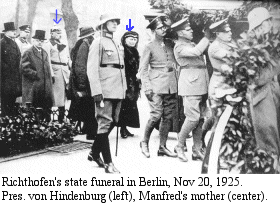 Soon after the war, Manfred had been re-buried at Fricourt with 18,000
other German soldiers. In November 1925, Baroness von Richthofen
and her youngest son Karl Bolko, who was by now 22 years old,
decided to bring Manfred home and bury him beside his father and
Lothar in Schweidnitz. By that time, many of his former comrades
had responsible positions in airlines, airplane companies and
in government. When they learned of the plan to bring Manfred
home to Schweidnitz, they begged his mother to bury her son in
the Invaliden cemetery in Berlin, as it would be fitting for the
Fatherlandís greatest combat hero. The Baroness had wanted no
publicity, but newspapers backed the idea and she agreed.
Soon after the war, Manfred had been re-buried at Fricourt with 18,000
other German soldiers. In November 1925, Baroness von Richthofen
and her youngest son Karl Bolko, who was by now 22 years old,
decided to bring Manfred home and bury him beside his father and
Lothar in Schweidnitz. By that time, many of his former comrades
had responsible positions in airlines, airplane companies and
in government. When they learned of the plan to bring Manfred
home to Schweidnitz, they begged his mother to bury her son in
the Invaliden cemetery in Berlin, as it would be fitting for the
Fatherlandís greatest combat hero. The Baroness had wanted no
publicity, but newspapers backed the idea and she agreed.
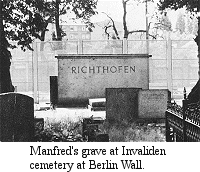 On November 20, 1925, seven years after the war, Manfred von Richthofen
was taken to the Invaliden cemetery in the largest military parade
Germany had seen since the war. Field Marshal von Hindenburg,
the president of the Weimar republic, accompanied by many dignitaries
in uniform, walked behind the family. The Kaiser, in exile in
Doorn Holland, sent a magnificent floral wreath. The following
year a large simple tombstone was placed at the grave, unadorned,
with only the block letters: RICHTHOFEN. Between the years 1961
and 1976 the grave was five feet from the infamous Berlin Wall
on the side of East Berlin. In 1976 the East German government
announced some border changes. The graves alongside the wall had
to be moved. The Richthofen family requested permission to move
the casket to the family plot in Mainz, West Germany. There Manfred
lies in eternal rest near his mother, his sister Ilse and his
brother Karl Bolko. We can only hope that he can finally rest
in peace.
On November 20, 1925, seven years after the war, Manfred von Richthofen
was taken to the Invaliden cemetery in the largest military parade
Germany had seen since the war. Field Marshal von Hindenburg,
the president of the Weimar republic, accompanied by many dignitaries
in uniform, walked behind the family. The Kaiser, in exile in
Doorn Holland, sent a magnificent floral wreath. The following
year a large simple tombstone was placed at the grave, unadorned,
with only the block letters: RICHTHOFEN. Between the years 1961
and 1976 the grave was five feet from the infamous Berlin Wall
on the side of East Berlin. In 1976 the East German government
announced some border changes. The graves alongside the wall had
to be moved. The Richthofen family requested permission to move
the casket to the family plot in Mainz, West Germany. There Manfred
lies in eternal rest near his mother, his sister Ilse and his
brother Karl Bolko. We can only hope that he can finally rest
in peace.
The Controversy
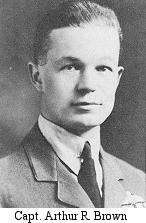 Captain Roy Brown of Ontario, Canada was officially credited with the
victory by the Royal Air Force. The Australian gunners on the
ground were just as convinced that they had brought down the warís
ace of aces. They accepted their generalís congratulations for
the kill. The question of who actually killed the Red Baron has
never been completely resolved. Most evidence points to the Australians.
Manfred flew about two miles after Brown had shot at him, which,
medical officers have agreed, would have been impossible, given
the nature of his wounds, had Brownís shot been responsible. Second,
the bullet hit him on the right side and came out two inches higher
on the left, indicating that it was fired upward, and not from
above. Since he was strapped in his seat, he could have turned
his head toward Brown, but not enough of his body so that Brown,
flying behind, could have hit him in the right side of the chest
and have the bullet come out on the left. As the esteemed author
William E. Burrows pointed out: So many Australians were firing,
that no one will ever know which one hit him. After all, what
counted was his life and legacy, not his death.
Captain Roy Brown of Ontario, Canada was officially credited with the
victory by the Royal Air Force. The Australian gunners on the
ground were just as convinced that they had brought down the warís
ace of aces. They accepted their generalís congratulations for
the kill. The question of who actually killed the Red Baron has
never been completely resolved. Most evidence points to the Australians.
Manfred flew about two miles after Brown had shot at him, which,
medical officers have agreed, would have been impossible, given
the nature of his wounds, had Brownís shot been responsible. Second,
the bullet hit him on the right side and came out two inches higher
on the left, indicating that it was fired upward, and not from
above. Since he was strapped in his seat, he could have turned
his head toward Brown, but not enough of his body so that Brown,
flying behind, could have hit him in the right side of the chest
and have the bullet come out on the left. As the esteemed author
William E. Burrows pointed out: So many Australians were firing,
that no one will ever know which one hit him. After all, what
counted was his life and legacy, not his death.
The author Peter Kilduff has done extensive research on Richthofen. He leaves us at the end of his marvelous book, Richthofen: Behind the Legend of the Red Baron, with this conclusion: "Within the span of his relatively short life, Richthofen earned a reputation of unquestioned bravery, and the ability to inspire total loyalty from his comrades and respect from his adversaries. Add to those qualities the colorful personal style and combat success of the "Red Baron", and the product is a larger-than-life figure who inspires interest to the point of fascination".
References
Kilduff, Peter. Richthofen: Behind the Legend of the Red Baron. John Wiley and Sons, Inc. New York, 1994.
Burrows, William E.. Richthofen: A True Story of the Red Baron. Harcourt, Brace & Co.. New York, 1969.
